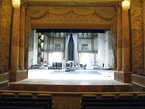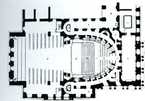EN
history of the theatresupplementtechnical dataHistoric equipmentRoyal Opera of Versailles
Ange-Jacques Gabriel
alias l´Opéra RoyalChateau de Versailles, | |
| show on the map | http://www.chateauversaillesspectacles.fr/meta_spectacle.php?metaspe=2 |
Important events
(detail)60. 's 18. century | construction
Built 1769-1770 as "Opéra Royal" by Ange-Jacques Gabriel for King Louis XV, based on an existing 17th century building by François Mansart.
(detail)16.5.1770 | opening
the Opéra was opened with Lully's "Persée" in celebration of the marriage of the dauphin .
(detail)1837 | reopening
Revived by King Louis-Philippe, re-decoration of the auditorium. Re-opened with Molière's "Le Misanthrope".
(detail)50. 's 20. century | Renovation
The theatre was renovated to the original design from 1770 between 1952 -55. Re-opened on 9th April of 1957 with Act II of the Rameau's "Les Indes Galantes".
People
Ange-Jacques Gabriel |main architect
Louis Jean-Jacques Durameau |painter
Augustin Pajou |interior designer
History
Additional information
No information has yet been entered
Add information

































